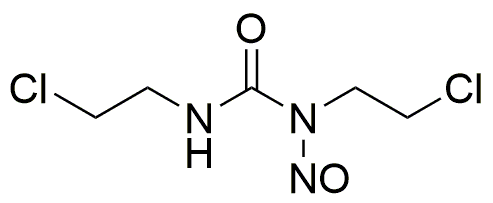Carmustine is widely utilized in research focused on:
- Cancer Treatment: Primarily used as a chemotherapy agent for treating various types of cancers, including brain tumors and multiple myeloma. Its ability to cross the blood-brain barrier makes it particularly effective for central nervous system cancers.
- Veterinary Medicine: Employed in veterinary oncology for treating tumors in pets, providing an option for pet owners seeking advanced treatment for their animals.
- Research Applications: Utilized in laboratory settings to study cancer cell behavior and resistance mechanisms, helping researchers develop new therapeutic strategies.
- Drug Formulation: Incorporated in the development of combination therapies, enhancing the effectiveness of other anticancer drugs and reducing the likelihood of drug resistance.
- Pharmaceutical Development: Serves as a model compound in the synthesis of new nitrosourea derivatives, aiding in the discovery of novel anticancer agents with improved efficacy and safety profiles.
Información general
Propiedades
Seguridad y normativas
Aplicaciones
Carmustine is widely utilized in research focused on:
- Cancer Treatment: Primarily used as a chemotherapy agent for treating various types of cancers, including brain tumors and multiple myeloma. Its ability to cross the blood-brain barrier makes it particularly effective for central nervous system cancers.
- Veterinary Medicine: Employed in veterinary oncology for treating tumors in pets, providing an option for pet owners seeking advanced treatment for their animals.
- Research Applications: Utilized in laboratory settings to study cancer cell behavior and resistance mechanisms, helping researchers develop new therapeutic strategies.
- Drug Formulation: Incorporated in the development of combination therapies, enhancing the effectiveness of other anticancer drugs and reducing the likelihood of drug resistance.
- Pharmaceutical Development: Serves as a model compound in the synthesis of new nitrosourea derivatives, aiding in the discovery of novel anticancer agents with improved efficacy and safety profiles.
Documentos
Hojas de datos de seguridad (HDS)
La SDS proporciona información de seguridad completa sobre la manipulación, el almacenamiento y la eliminación del producto.
Especificación del producto (PS)
La PS proporciona un desglose completo de las propiedades del producto, incluida la composición química, el estado físico, la pureza y los requisitos de almacenamiento. También detalla los rangos de calidad aceptables y las aplicaciones previstas del producto.
Certificados de análisis (COA)
Busque certificados de análisis (COA) ingresando el número de lote del producto. Los números de lote y de partida se pueden encontrar en la etiqueta de un producto después de las palabras "Lote" o "Lote".
Número de catálogo
Número de lote/lote
Certificados de origen (COO)
Este certificado de origen confirma el país en el que se fabricó el producto y también detalla los materiales y componentes utilizados en él y si se deriva de fuentes naturales, sintéticas u otras fuentes específicas. Este certificado puede ser necesario para cumplir con las normativas aduaneras, comerciales y regulatorias.
Número de catálogo
Número de lote/lote
Hojas de datos de seguridad (HDS)
La SDS proporciona información de seguridad completa sobre la manipulación, el almacenamiento y la eliminación del producto.
DownloadEspecificación del producto (PS)
La PS proporciona un desglose completo de las propiedades del producto, incluida la composición química, el estado físico, la pureza y los requisitos de almacenamiento. También detalla los rangos de calidad aceptables y las aplicaciones previstas del producto.
DownloadCertificados de análisis (COA)
Busque certificados de análisis (COA) ingresando el número de lote del producto. Los números de lote y de partida se pueden encontrar en la etiqueta de un producto después de las palabras "Lote" o "Lote".
Número de catálogo
Número de lote/lote
Certificados de origen (COO)
Este certificado de origen confirma el país en el que se fabricó el producto y también detalla los materiales y componentes utilizados en él y si se deriva de fuentes naturales, sintéticas u otras fuentes específicas. Este certificado puede ser necesario para cumplir con las normativas aduaneras, comerciales y regulatorias.

